|
Motion Computing R12
Sleek, lightweight ruggedized Intel Haswell-powered 12.5-inch full 1080p tablet with dual-mode input and a wealth of accessories
(by Conrad H. Blickenstorfer, with most photography by Carol Cotton)
In late March 2014, at a time where most available consumer tablets still had smallish 7 or 10-inch displays, tablet computing pioneer Motion, which is now part of Xplore Technologies, announced the rugged Motion R12 with a comparatively massive 12.5-inch screen. Motion created that new tablet specifically for mobile professionals who needed more screen real estate, more durability, more versatility, and more performance than is commonly available in consumer media tablets. RuggedPCReview lauded the R12 as a "well-conceived tablet" in our initial preview, and we've now had a chance for extended hands-on with an R12 production tablet.
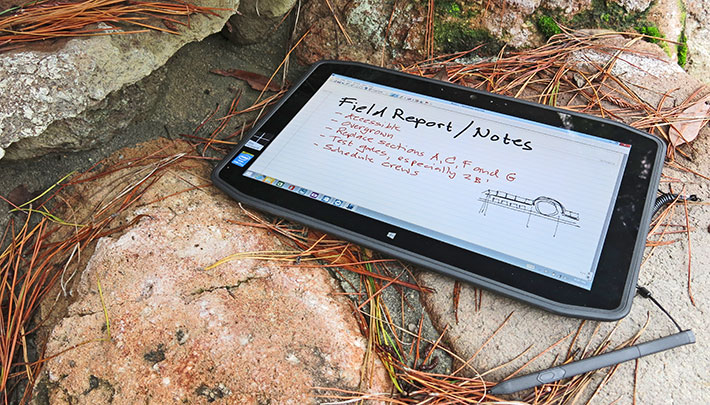
There's much to like. The Motion R12 has that large (for a tablet) 12.5-inch display with full 1920 x 1080 1080p resolution, measures 12.9 x 8.1 inches, is 0.65 inches thick, and weighs just under three pounds. While consumer media tablets weigh next to nothing these days, not too long ago three pounds was considered "ultra light," and also roughly what those little netbooks weighed that were so common before tablets arrived. It's amazing just how much roomier the screen feels than that of a standard 10-inch consumer media tablet. There's ample room to work on this tablet and then some.
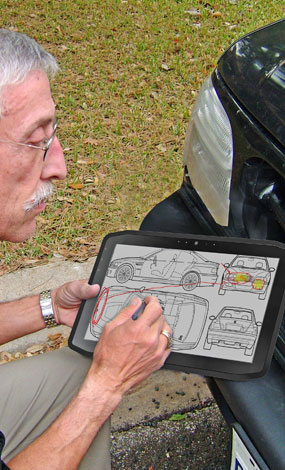 Continuing with specs, Motion offers 4 or 8GB of power-efficient DDR3L SDRAM and solid state disks with capacities of 64, 128 and 256GB. Wired communication includes a full-size USB 3.0 port, HDMI, a 3mm audio jack, docking, and there's also an SD card slot. Continuing with specs, Motion offers 4 or 8GB of power-efficient DDR3L SDRAM and solid state disks with capacities of 64, 128 and 256GB. Wired communication includes a full-size USB 3.0 port, HDMI, a 3mm audio jack, docking, and there's also an SD card slot.
As a modern device, the R12 has a 9-axis MEMS (Micro Electro Mechanical Sensors) array that includes an accelerometer, eCompass and gyroscope, and there's also an ambient light sensor. Motion has always been big on audio, and so the R12 includes a multi-directional array microphone system as well as two speakers.
For wireless, there's an Intel Dual Band Wireless-AC 7260 WiFi module that also includes Bluetooth 4.0. Optionally available is either 4G LTE mobile broadband with GNSS (a combo that can use our GPS and the Russian GLONASS GPS) or a dedicated GPS module based on u-blox 7 technology. And there are two cameras, with 2.0 megapixel resolution in the front and 8.0 megapixel in the rear.
The R12 being a commercial tool for professionals in various fields, Motion offers numerous extras and accessories that extend the tablet's features and abilities. An example is the optional "SlateMate" bolt-on module can include up to three separate I/O devices, including scanners, RFID, and even a legacy serial port, should it be required.
As for performance commensurate with the big screen and the expected professional grade use, that's provided by an Intel "Haswell" 4th generation i5 or i7 Core processor, indicating that the R12 is a higher end product. But more on that later.
Taking a closer look at the Motion R12
Unlike some of the newcomers to the tablet market, Motion has well over a decade's worth of experience in tablets. The company burst onto the scene back in 2001/2002 when Microsoft launched its Tablet PC initiative. By concentrating on tablets and tablets only, Motion managed to succeed where many other early tablet makers failed. And by concentrating on business and enterprise, Motion learned to meet the needs of those customers with specialized accessories, extensions, and solutions. So the experience to make, and support, something that really works for professionals is definitely there.
In terms of design, Motion has always subscribed to a form-follows-function philosophy with understated elegance rather than simply following the latest fashion trends. That was evident in the company's early adoption of Intel's eminently practical MCA (Mobile Clinical Assistant) reference design with its handle and integrated peripherals, a platform that serves Motion and its customers well to this day in the company's C5 and F5 product lines. Motion has also been an early adopter of all sorts of technologies that make a field professional's life easier. Examples are superior displays, high quality sound capture, dual mode input, and capacitive multi-touch when almost no one else had it.
So it's no surprise that, once again, Motion created a tablet that's different both visibly and under the hood. Below is a look at the R12 tablet from the front and from all four sides. Note how the R12 is slender for a ruggedized tablet, and also how all I/O is neatly integrated into the design.
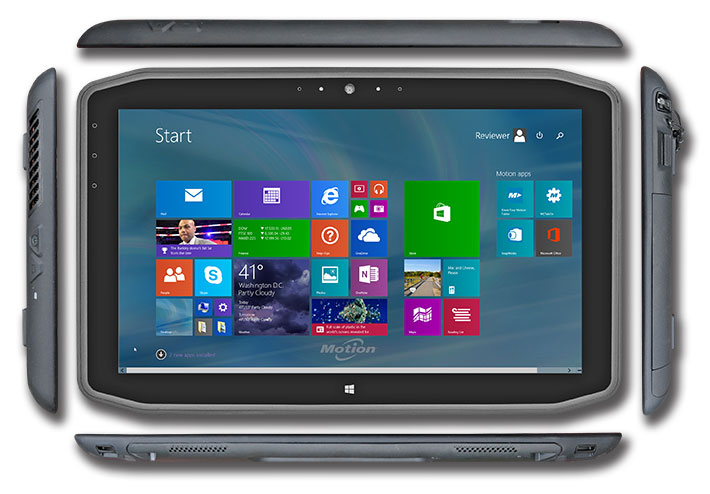
The one thing that makes the R12 instantly recognizable is its unique shape. Where virtually every other tablet is a rectangle with rounded corners, the R12 is sort of an elongated octagon, or a rectangle with its chamfered corners clipped at a shallow angle. Motion said they wanted something unusual and memorable to differentiate themselves from the crowd, and the sloped edges were designed to make it easy to pick the tablet up from a flat surface. A peek at the R12's insides (see farther down) provide further clues, and we think it's quite possible that this shape is less prone to impact damage.
The image below shows the right side of the R12 tablet with the protective rubber, hinged covers open.

Here's what's available, from left to right::
- Power adapter jack (the power brick is remarkably compact: 3.6 x 1.6 x 1 inches)
- 3.5mm audio-out port
- Full-size USB 3.0 port
- Full-size HDMI port
- SD/SDHC/SDXC card slot (tested with 32GB card)
- SIM card slot above the SD card slot
- Fingerprint reader
- Attachment point for supplied coiled pen tether
- Bay for the supplied Wacom active pen
The left side of the R12 contains the heat exchanger exhaust, the power button, a "security button" that issues a Ctrl-Alt-Del, and a battery charge indicator. The top sports no fewer than three microphones, two facing front and one rear. There are also separate volume up and down buttons. The bottom has the docking station contacts, dual speakers, and two loops to attach a carry handle.
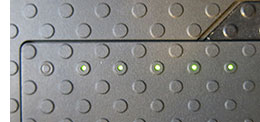 As is usually the case with Motion products, controls are small and tucked out of the way, rather than serving as design elements. Most buttons are implemented as slightly elevated areas in the rubbery housing material, with embossed icons. No color markings here that can easily scratch off. As is usually the case with Motion products, controls are small and tucked out of the way, rather than serving as design elements. Most buttons are implemented as slightly elevated areas in the rubbery housing material, with embossed icons. No color markings here that can easily scratch off.
Some functions are so well integrated that they are almost hidden. An example is the clever 5-LED charge meter of the battery. Both the LEDs and the activation button are built right into some of the hundreds of elevated little dots that make the device grippier to hold (see picture to the right). The activator button is in the dot to the left of the LEDs.
Design and construction
As far as construction is concerned, the Motion R12 consists of a polycarbonate shallow pan-like bottom half upon which the flat top part with the display fits like a cover. Everything's black, with the bottom part having a rubberized grip pattern designed to add friction to the back and help emphasize the rugged look. There's a rubber lip around the perimeter of the tablet that's raised a bit from the glass bezel to protect the display in case of a drop.
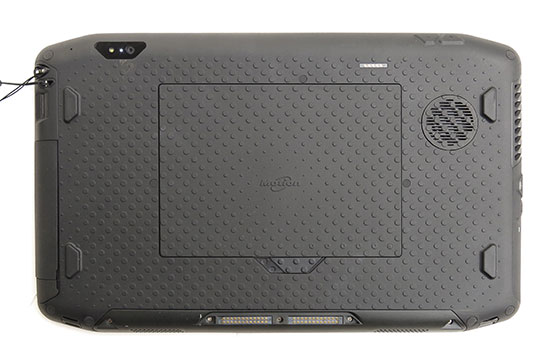 The image to the right shows the R12 from the back. Note the rear camera with its LED illuminator, the round fan air intake, the surface-mount docking pins, and in the center the battery. The image to the right shows the R12 from the back. Note the rear camera with its LED illuminator, the round fan air intake, the surface-mount docking pins, and in the center the battery.
The battery is a 6 x 4.5 inch affair that's only about 3/8th of an inch thick. It recesses into its compartment without an additional cover over it. We initially thought the R12 had a Lithium-Ion battery, but it's actually a Lithum-Polymer design that packs 43 watt hours (14.8 Volts, 2,900 mAh). The battery is secured in place with a single friction slider. It's unlikely that the battery should come loose by accident.
Opening the R12 is a bit of a challenge because several of the small Philips head screws that hold the two halves of the tablet together are hidden underneath little rubber plugs, some of which neatly blend into the housing's dotted surface treatment pattern. Once all have been found and undone, the two halves easily separate, with just one single ribbon cable connecting the two sides. Or so one thinks at first; there's also a second and very short ribbon for the touch subsystem that will come off and is not easy to put back in place.
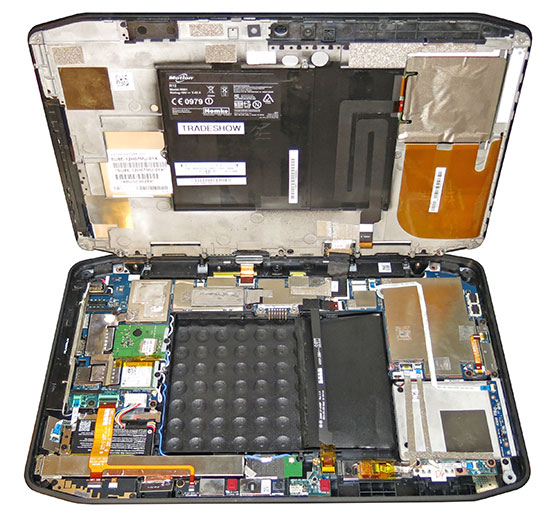 Inside, things look quite complex. The electronics in the bottom half of the housing remind of an elaborate settlement surrounding the battery compartment atrium. There's a U-shaped motherboard, numerous modules, boards, connections, bar codes, thermal conduits, heat exchangers, plenty of shielding, and so on. It's just about the opposite of the circuitry inside an iPad that consists of just a couple of tiny hyper-integrated boards. Inside, things look quite complex. The electronics in the bottom half of the housing remind of an elaborate settlement surrounding the battery compartment atrium. There's a U-shaped motherboard, numerous modules, boards, connections, bar codes, thermal conduits, heat exchangers, plenty of shielding, and so on. It's just about the opposite of the circuitry inside an iPad that consists of just a couple of tiny hyper-integrated boards.
What's also obvious, though, is that the R12 is a seriously rugged design. The top half of the R12 is anchored to a complex, very sturdy magnesium chassis that provides a solid mounting basis for the tablet's large display and Wacom digitizer.
Something else that quickly becomes obvious is how much care Motion's designers took in making sure nothing ever comes loose — all plug-in modules are not only secured in place with a screw, but there are also small metal retainers that keep any and all antenna connectors safely in place. And a benefit of the design with the chamfered corners is that it provides extra space for antennae and assorted subsidiary boards and modules.
Overall, this is more of the more complex designs we've seen. What it means is that Motion can probably relatively easily update and customize the unit with replacement or enhancement modules and components.
Sealing between the two halves of the housing is interesting. It is via a soft plastic sleeve that fits around the entire top half perimeter, and then forms a seal against the slightly bevelled inside perimeter of the bottom half once the two halves are compressed together.
Available with two very different Intel "Haswell" Y-Series processors
Performance is always a major issue in mobile designs. Customers want maximum speed, but that means higher costs and usually larger size and weight because of a bigger battery. In the end, designing the system means arriving at an optimal compromise and balance between performance, size, weight and cost. For the R12, intended to be a professional grade computing tool, Motion decided to go with Intel Core power and versatility rather than a considerably less complex Intel Atom-based solution, but it had to be the most power-efficient Core variant possible. That meant Intel's Y-Series.
The dual-core 1.7GHz Intel Core i7-4610Y processor our review R12 tablet came with can reach turbo speeds of up to 2.9GHz. The chip, really a System on Chip (SoC), is part of Intel's "Haswell" 4th generation of Core processors. Y-Series chips were initially created by Intel for passively cooled tablets and 2-in-1 devices (Sony used the i7-4610Y in their Vaio Tap 11 2-in-1). 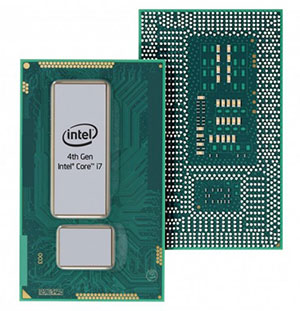 Its Thermal Design Power, including graphics and integrated chipset, is just 11.5 watts, way lower even than the super-efficient U-Series processors we now commonly see in rugged tablets and convertibles. What's more, Intel introduced a new concept called Scenario Design Power (SDP), which in the i7-4610Y is just 6 watts — Intel Atom territory. The way we understand it, SDP refers to the power the chip consumes doing standard tablet tasks. The idea here is that the chip can do everyday tasks at full speed, using just 6 watts. It can handle significantly higher load, but — in passively cooled systems — either not at full speed or only in short bursts. Its Thermal Design Power, including graphics and integrated chipset, is just 11.5 watts, way lower even than the super-efficient U-Series processors we now commonly see in rugged tablets and convertibles. What's more, Intel introduced a new concept called Scenario Design Power (SDP), which in the i7-4610Y is just 6 watts — Intel Atom territory. The way we understand it, SDP refers to the power the chip consumes doing standard tablet tasks. The idea here is that the chip can do everyday tasks at full speed, using just 6 watts. It can handle significantly higher load, but — in passively cooled systems — either not at full speed or only in short bursts.
|
Motion R12 CPUs (see full specs)
|
Intel Core
|
Intel Core
|
|
Model
|
i5-4210Y
|
i7-4610Y
|
|
Code Name
|
Haswell
|
Haswell
|
|
Lithography
|
22nm
|
22nm
|
|
Cores/Threads
|
2/4
|
2/4
|
|
Base Clock Speed
|
1.50 GHz
|
1.70 GHz
|
|
Turbo Speed
|
1.90 GHz
|
2.90 GHz
|
|
Thermal Design Power (TDP)
|
11.5 watts
|
11.5 watts
|
|
Scenario Design Power (TDP)
|
6 watts
|
6 watts
|
|
Smart Cache
|
3MB
|
4MB
|
|
Instruction set
|
64-bit
|
64-bit
|
|
Integrated graphics
|
HD Graphics 4200
|
HD Graphics 4200
|
|
Graphics base speed
|
200 MHz
|
200 MHz
|
|
Graphics max speed
|
850 MHz
|
850 MHz
|
|
USB 3.0
|
Yes
|
Yes
|
|
Intel vPro
|
No
|
Yes
|
|
Intel Virtualization
|
No
|
Yes
|
|
Intel SIPP
|
No
|
Yes
|
|
Intel Trusted Execution
|
No
|
Yes
|
Note that Motion offers the R12 tablet with either a Core i5-4210Y or the Core i7-4610Y in our test unit. The table to the right shows a comparison of the chips' major specs. At first sight, there doesn't seem to be a great difference between the two, though Intel charges about $110 more for the i7 version than for the i5, and that's in manufacturer quantities. So why would one select the pricier i7?
One big difference is clock speed, 1.70GHz for the i7, 1.50GHz for the i5. Not much of a difference, but the i7 can reach bursts of up to 2.90GHz whereas the i5 tops out at a much lower 1.90GHz. Since both chips have the same scenario design power and thermal design power, i.e. they can go faster only so long as they don't exceed a certain temperature, the mechanics of the much higher burst speed of the i7 version are not clear, and we'd have to benchmark both versions under various operating conditions to get an idea of real-world performance characteristics. There's one hint, though: while Intel originally designed the Y-Series chips for fanless devices, the R12 does have a small fan, and therefore helps the i7 chip stay cooler, and thus likely operate at a higher performance level for longer.
To use one of our beloved automotive analogies, the two chips are like small turbocharged engines that can make a lot of power for short periods. The i7 can operate at much higher "boost" (2.90GHz max instead of just 1.90GHz), and the R12's fan acts like an automotive intercooler that allows longer periods of maximum boost.
As is, we ran the R12 through our standard PassMark and CrystalMark benchmark suites to test its performance in various categories. To provide an idea of where the R12 with its Y-Series Haswell chip fits in we're also listing the results of Motion's own newly upgraded CL920 tablet as well as Getac's 11.6-inch F110 tablet with a U-Series ultra-low voltage chip, Panasonic's 10.1-inch Toughpad M1 with a third-gen ultra-low voltage chip, and a couple of tablets from Samwell and Winmate, using less costly Intel Bay Trail processors. Here are the results:
|
Motion Computing R12 Benchmarks and Comparisons
|
|
PERFORMANCE COMPARISON
|
Motion
|
Motion
|
Getac
|
Panasonic
|
RUGGEDBOOK
|
Winmate
|
|
Model
|
R12
|
CL920
|
F110
|
FZ-G1
|
PC-760
|
M101B
|
|
Processor Type
|
Intel Core
|
Intel Pentium
|
Intel Core
|
Intel Core
|
Intel Celeron
|
Intel Celeron
|
|
Processor Type: Intel
|
i7-4610Y
|
N3540
|
i5-4300U
|
i5-3437U
|
N2930
|
N2920
|
|
Code name
|
Haswell
|
Bay Trail
|
Haswell
|
Ivy Bridge
|
Bay Trail
|
Bay Trail
|
|
Thermal Design Power (TDP)
|
11.5 watts
|
7.5 watts
|
15 watts
|
17 watts
|
7.5 watts
|
7.5 watts
|
|
CPU Clock
|
1.70GHz
|
2.16GHz
|
1.90GHz
|
1.90GHz
|
1.83GHz
|
1.86GHz
|
|
CPU Turbo
|
2.90GHz
|
2.66GHz
|
2.90GHz
|
2.90GHz
|
2.16GHz
|
2.00GHz
|
|
CPU Cores/Threads
|
2/4
|
4/4
|
2/4
|
2/2
|
4/4
|
4/4
|
|
Graphics
|
Intel HD Graphics 4200
|
Intel HD Graphics
|
Intel HD Graphics 4400
|
Intel HD Graphics 4000
|
Intel HD Graphics
|
Intel HD Graphics
|
|
CPU Mark
|
3,569.1
|
2,635.7
|
3,516.6
|
2,874.3
|
2,177.9
|
1,999.8
|
|
2D Graphics Mark
|
501.6
|
183.4
|
488.5
|
359.2
|
190.0
|
147.0
|
|
Memory Mark
|
1,222.4
|
550.1
|
1,183.6
|
870.8
|
456.4
|
396.3
|
|
Disk Mark
|
2,243.7
|
2,323.8
|
3,943.7
|
4,682.4
|
2,087.3
|
2,045.0
|
|
3D Graphics Mark
|
410.1
|
146.5
|
349.6
|
282.7
|
142.8
|
121.5
|
|
Overall PassMark
|
1,751.8
|
1,318.7
|
2,061.6
|
1,953.5
|
1,131.4
|
1,055.4
|
|
ALU
|
41,840
|
34,814
|
43,631
|
42,940
|
29,849
|
26,407
|
|
FPU
|
39,598
|
29,921
|
40,249
|
40,683
|
24,086
|
22,883
|
|
MEM
|
43,164
|
22,989
|
30,680
|
38,698
|
20,136
|
18,836
|
|
HDD
|
37,594
|
29,423
|
40,662
|
41,328
|
32,309
|
36,656
|
|
GDI
|
15,891
|
6,312
|
15,019
|
14,451
|
6,001
|
4,680
|
|
D2D
|
7,000
|
3,792
|
6,897
|
1,657
|
3,915
|
3,581
|
|
OGL
|
11,732
|
4,244
|
11,438
|
5,794
|
3,698
|
3,331
|
|
Overall CrystalMark
|
196,819
|
131,495
|
188,576
|
185,551
|
119,994
|
116,374
|
The data is quite interesting. At least in benchmark testing in our lab, the super-low voltage Y-Series chip seems to have no problems matching standard U-Series chips with much higher 15 and 17 watt thermal design power ratings in raw processor performance. Graphics performance, likewise, was excellent. But again, we don't know what limitations Intel's "scenario design power" might have on sustained performance under heavy load and high temperatures.
Compared to lower-end Bay Trail-based products, the R12 has a significant performance advantage across the board (as it should, given the large difference in price and complexity of the involved processors). For those undecided between Motion's R12 and the lower-end (but very quick) CL920, the R12 is probably overall about another 40-50% faster.
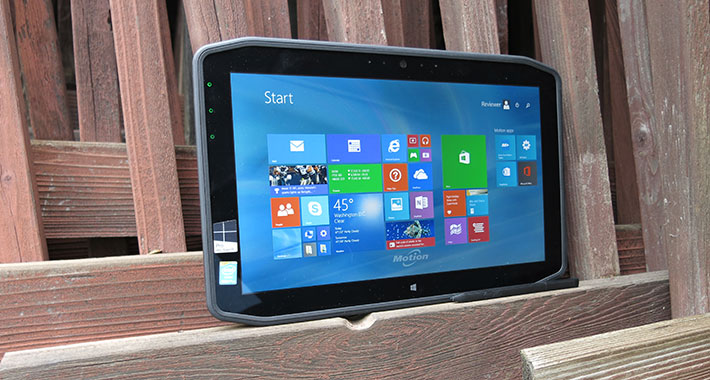
If the R12 were primarily targeted at extreme operating environments, we'd be a bit concerned about the use of Intel's Y-Series chips. But this is, as Motion puts it, a tablet "designed to empower the worker who moves from the field to the vehicle to the office." Between that intended use and the R12's fan cooling, customers may well get their high performance cake and eat it, too.
Should you get the i7 version or save some money and go with the i5? Under load we don't expect much difference in performance, but in everyday use, the i7 will provide speed bursts that may make a noticeable difference. Also, any deployment that intends to make use of various special Intel technologies (like vPro) may require the i7.
Power consumption
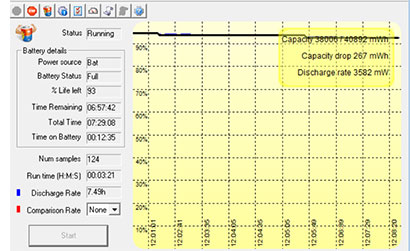 What impact does the R12's interesting Y-Series processor have on power consumption and battery life? As is our standard procedure, we used Passmark Software's BatteryMon power management benchmark utility to measure the R12's power draw under various operating conditions. What impact does the R12's interesting Y-Series processor have on power consumption and battery life? As is our standard procedure, we used Passmark Software's BatteryMon power management benchmark utility to measure the R12's power draw under various operating conditions.
With the Windows power options set to "Motion Optimized" and display brightness at its lowest, we saw an idle power draw of just 3.2 watts. In the Windows "Power Saver" mode we saw the same 3.2 watts, and in Windows "High Performance" mode about 3.6 watts, all with the backlight at its lowest. That's with the tablet being awake, just idling along.
In Motion Optimized mode with the backlight at 50% we saw 3.8 watts, and with the backlight at full strength 4.4 watts. Putting load on the processor by running full-screen 1080p MP4 video, we saw about 6.8 watts with the screen on full bright.
What do those extraordinarily low power draw figures mean in terms of projected battery life? The R12's thin Li-Polymer battery has a capacity of 43 watt-hours, the same as the iPad 3 and 4. That wouldn't seem very much for a Intel Core-based Wintel tablet, but it seems more than enough with a frugal backlight and a Y-Series processor under the hood. Dividing the 43 watt-hours by the 3.2 watt minimum draw means well over 13 hours of battery life with the system staying awake the whole time. Even under the maximum 6.8 watt draw we observed, it'd still mean well over six hours. Motion itself claims "over 9 hours" and that seems quite achievable.
That said, we did notice a few things. First, while power draw of systems with low and standard voltage chips is generally quite steady and thus predictable, the Y-Series chip seems to shift in and out of various power conservation modes, with a corresponding fluctuation of power draw. Second, our measured figures where with the unit's fan off. We noticed significantly higher power draw whenever the fan (which has variable speeds) came on.
Large, high-quality 12.5-inch full HD display
No discussion of a Motion product would be complete without commenting on its display. That's because they always seem to be ahead of the curve. Not only does the R12 offer an unusually large screen with the same full 1920 x 1080 pixel resolution that's providing high definition video on virtually all of today's large flatscreen TVs, but there's also Gorilla Glass 3 that provides even more protection against breakage and scratching than the first two generations.
Overall, display quality is supremely important in tablets. That's because while users generally sit down in front of a notebook or desktop display and look at it head-on, the viewing angle of tablets varies depending on how it's being held. 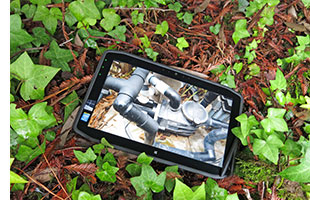 Which means that the display's ability to control reflections and producing a steady, unchanging image regardless of the angle from which the display is viewed is important. Which means that the display's ability to control reflections and producing a steady, unchanging image regardless of the angle from which the display is viewed is important.
The R12 display, which uses IPS (In Plane Switching) technology, offers a perfect horizontal and vertical viewing angle, which means the picture should remain unchanged within that very wide angle. The picture indeed does remain viewable throughout that range, with color remaining true and unchanged when viewed from above, below, left and right.
Other than referring to the use of Gorilla Glass, Motion's documentation doesn't specify what measures the company took to maximize viewability and control reflections. In modern displays that's usually done by minimizing the number of reflective surfaces in the many layers of a typical LCD assembly via bonding layers together and via polarizers and anti-reflective and anti-glare coatings. As is, the R12 display surface is glossy like the great majority of tablets available today.
How well does it work? Rather well. The pictures below show the R12 side by side with an Apple iPad 3. The iPad has a very good display and it's being used by tens or hundreds of millions outdoors every day.
The first picture below shows the two tablets in bright outdoors in a semi-shaded area with plenty of contrasts. Both screens have their brightness at their highest setting. What's instantly obvious in the top row are the harsh mirror-like refection on the iPad, whereas the R12 screen shows none. When switching the position of the tablets, the R12 also reflects a bit, but the reflections are more muted and have a slightly blueish hue.
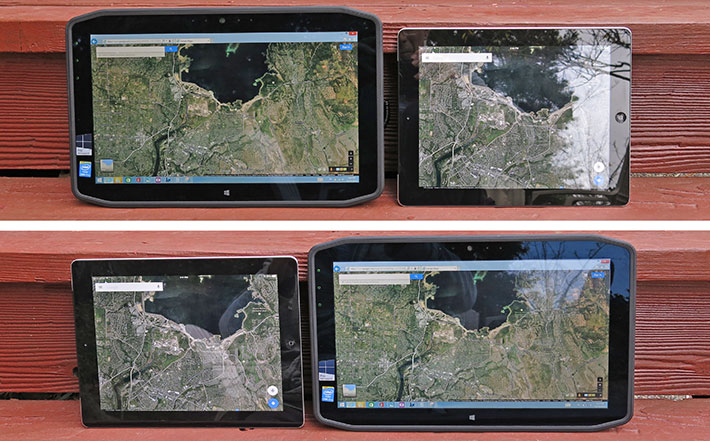
In the picture collection below, the two angle comparisons again show some reflections on both tablets, with the R12 offering somewhat better reflection control.
The comparison picture on the right shows both tablets facing the open sky on a bright but overcast day without direct sun. Neither of the tablets washes out completely, and once again there is the slightly blueish hue on the R12 and a noticeable difference in the harshness of the reflections between the tablets.
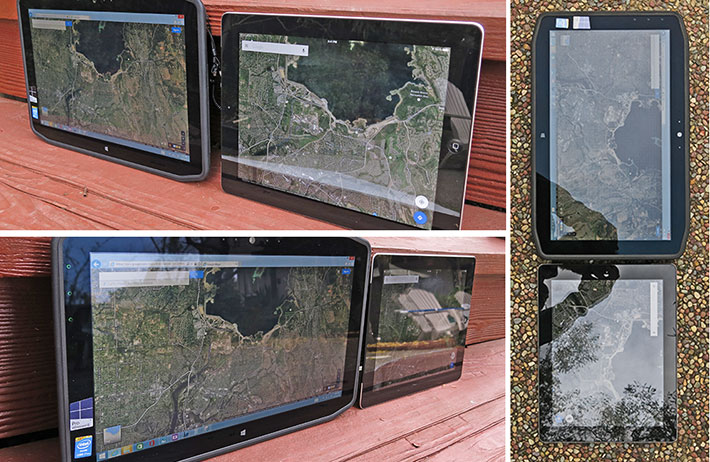
As far as display size and resolution go, roughly 10 inches diagonal is currently considered by many the sweet spot for mobile tablets. Apple chose it for the iPad, and the iPad's boxier 4:3 aspect ratio remains quite common in tablets. However, the R12's wider 16:9 ratio works better in landscape mode, and that's how Windows is used by far the most often.
Overall, the R12's 1920 x 1080 FHD display resolution makes for a very crisp and sharp viewing experience. It's not quite "retina" class as individual pixels remain just barely visible. 1920 x 1080 pixel on the R12's 12.5-inch screen translates into about 176 dots per inch, behind the Microsoft Surface Pro models' 208 to 216 dpi range, but ahead of numerous Kindle Fire and Samsung Galaxy models, and far ahead of most notebook and desktop monitors.
Digitizer: capacitive multi-touch and active pen
Using a desktop operating system such as Microsoft Windows on a tablet means somehow making things work without the ubiquitous mouse Windows was designed around. That has always been a challenge, one that Microsoft tried to address with an active pen when it launched its Tablet PC/Windows XP Tablet PC Edition initiative over a decade ago.
For a very long time, tablets used either resistive touch that worked with a finger or a passive stylus, or they had an active digitizer with a special pen, usually of the Wacom variety, and sometimes they used both together. That all changed when first the iPhone and then the iPad popularized capacitive multi-touch with its effortless panning and pinching and zooming.
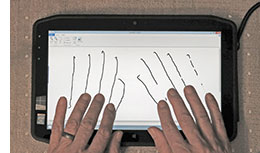 With Microsoft Windows, capacitive touch is a mixed bag because, on the one hand, Windows 8.1 pretty much requires it for its tiled/new-style/Metro interface but, on the other hand, Windows 7 and the legacy Desktop in Windows 8.x with their small check boxes and narrow scrollers was clearly designed for use with a mouse. With Microsoft Windows, capacitive touch is a mixed bag because, on the one hand, Windows 8.1 pretty much requires it for its tiled/new-style/Metro interface but, on the other hand, Windows 7 and the legacy Desktop in Windows 8.x with their small check boxes and narrow scrollers was clearly designed for use with a mouse.
Motion addressed this issue in the R12 by giving it both 10-point capacitive multi-touch (as demonstrated in MS Paint in the picture to the right) and a standard Wacom inductive pen that does not need a battery. The Wacom active digitizer system has literally been around for decades and is as mature as it can get.
Among the Wacom technology's strengths is "hovering," i.e. the cursor following the tip of the pen even if the pen does not touch the surface. And since Microsoft always supported the Wacom digitizer, there's plenty of software, including neat utilities, that support it. One of the problems with Wacom pen tablets used to be that you were totally sunk if you lost the (costly) pen. That's not an issue with the R12 because its super-responsive capacitive touch interface allows users to operate the tablet effortlessly, albeit not quite as precisely, even without the pen.
Cameras good enough for real work
Like virtually all tablets, smartphones and notebooks these days, the Motion R12 has integrated imaging capabilities via dual cameras. One of them faces to the front and has 2.0 megapixel resolution. This one is for video conferencing. The other faces to the rear and has 8.0 megapixel resolution. That one is for workflow documentation.
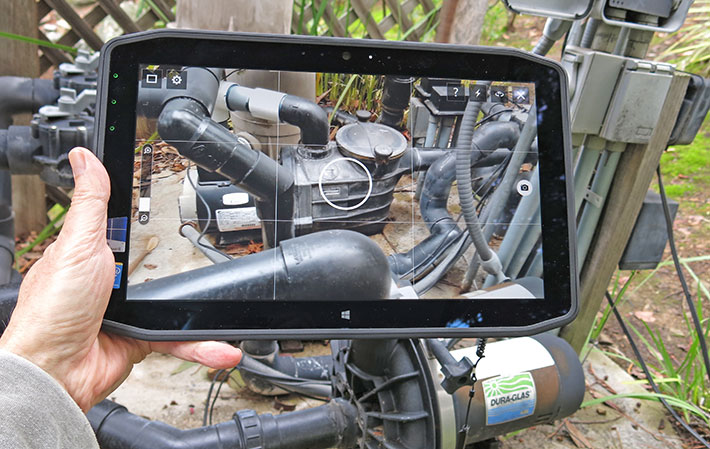
Our review machine came with the SnapWorks camera app by Motion. Its user interface is uncluttered and intuitive, and the R12 makes a satisfying mechanical camera clicking sound whenever a picture is taken. Motion developed this app specifically to support inspection workflows where the ability to quickly annotate a photo with field notes using the pen or touch interface comes in handy, as does the ability to automatically incorporate a GPS and time stamp.
The pictures below were taken with the R12's camera in its highest resolution (click on the sample pics for a full-size version of the picture compilation).
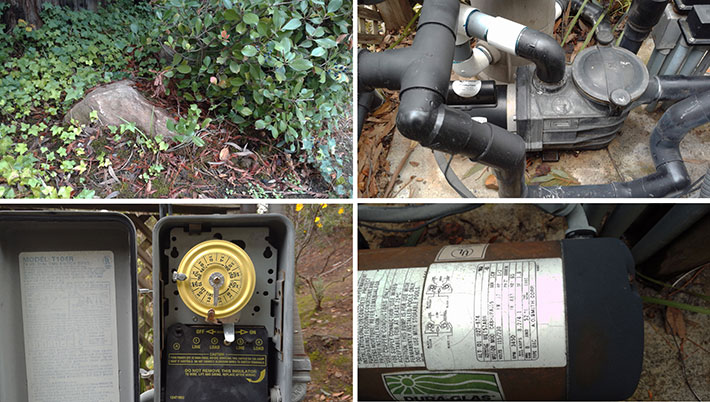
We only had limited time to work with the R12's cameras, but what we learned was quite encouraging. For years, one of our biggest gripes with vertical and industrial market rugged computing gear was the low quality of its integrated cameras, to the extent where most were hardly useful at all. Given that every smartphone today has good to excellent cameras, something had to happen. Apparently Motion agreed, as the internal documentation camera of the R12 is vastly better than most of what we've seen.
We don't know the origin and all the specs of the R12 documentation camera and we didn't have enough time to draw definite conclusions, but, as the title of this section suggests, the R12 cameras are clearly good enough for real work, and that's big progress.
Docks, accessories, and peripherals
Motion offers a large variety of docks and accessories for the R12 tablet. They are designed to provide protection and extra functionality. Available, among other, are:
- Top left: the R12 Series dock transforms the R12 into a full desktop computer. It has an integrated battery charger.
- Top right: the R12 Series wireless keyboard stand automatically pairs with any R12 tablet. When not in use, it can be magnetically attached to the back of the tablet.
- Bottom left: the lockable R12 Series Secure Mobile Vehicle Dock can accommodate the tablet even with the SlateMate or carrying case.
- Bottom right: the R12 Series SlateMate data acquisition module can be configured with up to three I/O devices (serial port, 1D/2D bar code reader, HF RFID).
Note that Motion designed the optional keyboard as a "tablet first" keyboard. It attaches to the tablet in an ergonomic way that doesn't prevent the user from accessing the display and operating the tablet while the keyboard is attached. Motion also developed a proprietary communication protocol called "Easy Pair" that allows the keyboard to connect automatically and securely while eliminating the need to enter a pairing code.
Remarkable ruggedness
One of the issues facing vertical and industrial market tablet manufacturers is just how rugged to make their tablets. Hundreds of millions are using tablets now, but with the trend towards thinner and thinner consumer market tablets, a lot of those tablets are simply too fragile for field or even enterprise use. So with business customers wanting tablets that hold up on the job, but also look and feel as much as the popular consumer products, what degree of ruggedness is right?
 Motion's approach is to offer tablets that are durable and tough enough for their intended deployments, but without making them too big and heavy. The 3-pound R12 is a primary example of that philosophy. Motion's approach is to offer tablets that are durable and tough enough for their intended deployments, but without making them too big and heavy. The 3-pound R12 is a primary example of that philosophy.
In their ruggedness testing, Motion concentrated on scenarios the tablet will likely encounter, and situations and locations where the R12 will primarily be deployed. That included extensive vehicle crash testing with the tablet and its docks.
The R12 can handle 4-foot drops, which is important because a tablet dropped to the ground while being operated in a standing position will fall from approximately that height.
The R12 further has IP54 sealing, where the "5" means protection against dust and the "4" protection against water spray from all directions, albeit with limited ingress permitted. That's not the total immunity to the elements that an IP67 rating provides, but definitely good enough for the R12's intended use.
The R12's operating temperature range is a fairly wide 14 to 131 degrees Fahrenheit, which should cover the vast majority of intended deployments for this class of tablets.
As usual, Motion also provides a long lists of safety and regulatory requirements that the R12 meets, and additional ruggedness criteria are probably covered in there.
Subjectively, Motion's slender business tablets don't generally look as tough and rugged as they actually are. But as our internal inspection revealed, looks are deceiving. With its heavy-duty magnesium frame inside and the rubberized guards and protection outside, the R12 can handle a significant amount of punishment. Then add the shatter and scratch-resistant Gorilla Glass, the skillfully integrated controls, the lack of trim that may come off, and the R12 is a trust-inspiring unit indeed.
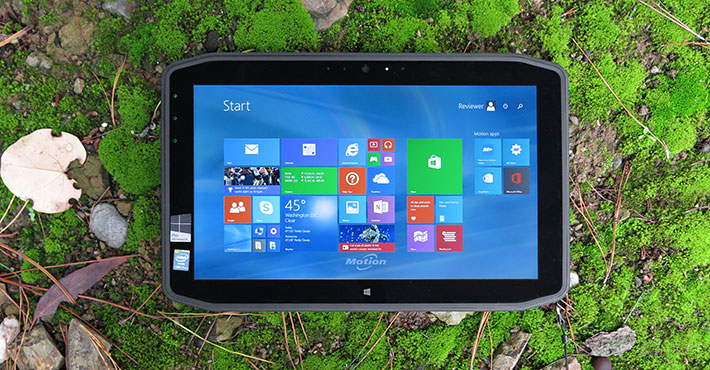
Note that Motion also lists unspecified additional MIL-STD-810G testing, but the documentation does not state which specific testing was performed.
Summary: Motion Computing R12 rugged tablet computer
The uniquely designed R12 is the venerable Motion J3600's sleeker, lighter, and faster successor. It is a very well-conceived tablet that offers enterprise and business customers what Motion found they want and need in real life and on the job.
 Powered by your choice of an ultra-low voltage Intel "Haswell" Core i5 or i7 Y-Series processor, the R12 provides excellent performance without quickly draining its externally accessible and replaceable 43 watt-hour Lithium-Polymer battery. Motion wisely included a small fan to allow the processors to operate at high speed even under load and higher temperatures. Powered by your choice of an ultra-low voltage Intel "Haswell" Core i5 or i7 Y-Series processor, the R12 provides excellent performance without quickly draining its externally accessible and replaceable 43 watt-hour Lithium-Polymer battery. Motion wisely included a small fan to allow the processors to operate at high speed even under load and higher temperatures.
The large 12.5-inch display offers full 1920 x 1080 pixel HD resolution, the same as HDTVs. It is very sharp and bright enough even for outdoor use. Optical treatments soften the reflections inherent in "glossy" displays, and the screen offers excellent viewability from any angle. The 10-point capacitive multi-touch interface works as smoothly and effortlessly as users have come to expect from consumer devices. For precision work, the R12 also has an active Wacom digitizer pen that does not need a battery.
The Motion R12 has a full-size USB 3.0 port, a standard HDMI port, an audio jack, three microphones, dual speakers, an SD Card reader, a fingerprint reader, and it can accommodate scanners, RFID, and even a legacy serial port through its optional "SlateMate" bolt-on module. The integrated 8-megapixel documentation camera and Motion's SnapWorks camera application can easily be used for high quality workflow documentation.
The Motion R12 is a very solid and ergonomic design that is instantly recognizable with its unique chamfered corners. A hefty magnesium frame inside the unit provides strength, and all ports ports are well-sealed with tight-fitting rubber plugs.
With the R12, Motion Computing offers a rugged, modern and highly configurable Windows tablet with strong performance and a bright, sharp 12.5-inch capacitive multi-touch display large enough even complex applications. -- Conrad H. Blickenstorfer, December 2014
Motion Computing R12 Specs:
| Status |
Added 03/2014, full review 12/2014
|
| Type |
Rugged Windows tablet
|
| Processor |
Intel "Haswell" Core i7-4610Y, or
Intel "Haswell" Core i5-4210Y
|
| CPU Speed |
i7-4610Y: 1.7/2.9 GHz, 4M cache
i5-4210Y: 1.5/1.9 GHz, 3M cache
|
| Chipset |
Intel QM87
|
| Graphics |
Intel HD Graphics 4200
|
| CPU Thermal Design Power |
11.5 watts |
| OS |
Windows 8.1 Professional 64-bit, Windows 7 Professional 64-bit |
| Memory |
4GB or 8GB 1,600MHz DDR3L SDRAM
|
| Display |
Wide Viewing Angle IPS TFT LCD with LED backlight and scratch- and damage-resistant Corning Gorilla Glass 3 |
| Display Size/Resolution |
12.5-inch/1920 x 1080 pixel Full-HD |
| Digitizer |
Dual-mode capacitive 10-point touch and Wacom active pen |
| Keyboard |
Onscreen keyboard, optional wireless hardware keyboard using EasyPair technology |
| Navigation |
Stylus, touch |
| Storage |
64GB, 128GB or 256GB Solid State Drive
|
| Expansion slots |
1 x SD Card, 1 x SIM card |
| Housing |
Rubberized enclosure over magnesium-alloy internal frame |
| Size |
12.9 x 8.1 x 0.65 inches (328 x 206 x 17 mm) |
| Weight |
2.95 pounds (1.34 kg.) incl. battery pack |
| Operating temperature |
(14° to 131°C) (-10° to 55°C)
|
| Ingress protection |
IP54 |
| Altitude |
Unknown
|
| Drop/shock |
4-foot drops |
| Vibration |
Vehicle crash tested both tablet and vehicle dock |
| Power |
Rechargeable, replaceable externally accessible 14.8 Volt, 2,900mAh 43 WHr Lithium-Polymer ("over 9 hours")
|
| Cameras |
Front-facing 2.0-megapixel camera, rear-facing 8.0-megapixel camera |
| Sensors |
9-axis MEMS (accelerometer, eCompass, gyroscope), ambient light
|
| Interface |
1 x USB 3.0, 1 x HDMI, 1 x 3mm audio, power, dock
|
| Wireless options |
Intel Dual Band Wireless-AC 7260 plus Bluetooth 4.0, dual array front mics, rear mic; optional 4G LTE mobile broadband with GNSS (GPS + GLONASS) OR Navisys Technology GE-730 (u-blox 7) GPS module with SBAS
|
| Price |
Starting at US$2,295 |
| Product page |
Motion R12 web page |
| Spec sheet |
 Motion R12 brochure (PDF) Motion R12 brochure (PDF)
|
|
Contact
|
Xplore Technologies
14000 Summit Drive, Suite 900
Austin, TX 78728, USA
Tel: (888) 449-7567
Tel: (512) 336-7797
Web: www.xploretech.com
|
(copyright 2014 RuggedPCReview.com)
|



